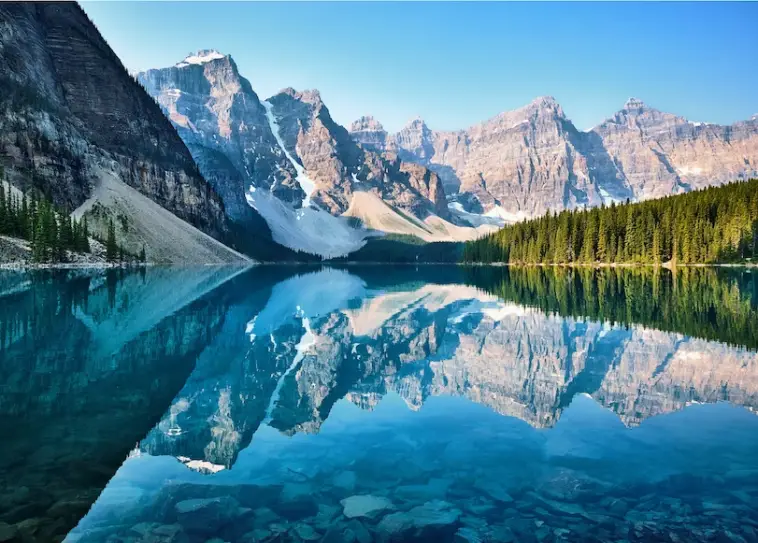When in search of stunning views and picturesque landscape, Canada come to mind. The vast inhabited land in the country has allowed for wildlife and natural features to take their own course and grow into something extraordinarily beautiful, out of negative human influence. The turquoise waterbodies, large glaciers, waterfalls that look their best when completely frozen, towering rugged mountains, and vast parks with wildlife abundance are a few of what Canada holds for tourists.
To make this easier, the country boasts an excellent railway system that can convey people to most of these sites, regardless of distance. There is the 540-kilometer Toronto to Montreal Train, for instance, that also allows an enjoyable 5-hour ride with spectacular attractions. With transportation sorted and loads of sites to see, let’s dive into Canada’s most picturesque places.
Banff National Park and The Valley of the Ten Peaks
Banff National Park is Canada’s first national park and the pinnacle of the country’s park system. It has cool montane weather and is home to over 260 species of birds as well as 56 known mammal species, including bears, elks, and moose. As a result of the discovery of some of Canada’s earliest known human remains in this area in the Vermillion Lakes, this park is littered with hundreds of archaeological pits. The Albertan mountains’ tooth-like peaks give this park a dashing, rough appearance.
This stunning park can be a pit stop on your way to the national parks in the Rocky Mountains because it is connected to Jasper National Park to the north and borders Yoho National Park to the west. By the way, don’t forget to visit the mountainous Lake Louise and Moraine Lakes. The breathtaking Valley of the Ten Peaks in the park is home to the picturesque, glacier-fed Moraine Lake. With temperatures that rarely rise beyond 5 °C, Lake Louise is one of Canada’s most photographed locations. This lovely, turquoise-colored lake doesn’t thaw out until June each year and is home to tiny species like cutthroat trout and mountain whitefish.
Gros Morne National Park.
Would you like to see the earth naked? Head to Gros Morne National Park, Newfoundland and Labrador. You can observe the earth’s mantle rocks and the deep ocean crust in this 180,500-hectare park in Newfoundland. Due to this exposure, the park is protected by UNESCO because it is thought to reflect “a rare example of continental drift.” The mountains in the group have a tranquil, serene appearance. This is consistent with the French name “Gros Morne,” derived from the name of the park’s second-highest mountain peak in Newfoundland at 2,644 ft, which translates as “great somber.” The park is home to a wide variety of breathtaking natural attractions, such as falls, fjords, an alpine plateau, coastal lowlands, cliffs, and crystal-clear lakes.
The top of the Tablelands offers the park’s most beautiful vista. You may reach the Tablelands with a half-day adventure or a day hike, where you can admire the stunning contrast between the turquoise saltwater and adjacent green hills. The Trout River Pond, another feature of the park, is a little body of water tucked away between trees for quiet and protection from the elements. Visitors can kayak, boat, or walk the Trout River Trail at the pond.
Okanagan
Source: Unsplash
Okanagan is a five-in-one beautiful location in Canada. It has a valley known for its flowing vineyards and forests; a mountain that leads to beautiful lake views; Okanagan Lake is ideal for boating; the Okanagan Mountain Provincial Park, located east of the lake and home to significant wildlife; and, finally, the Okanagan Lake Provincial Park, which is home to non-native flora and serves as a haven for several bird species. The Okanagan Valley has a colourful history and is an important historical site, evident by the archaeological sites found there. Pictographs, thought to be drawn by the First Nations (Indians), can be found on canyon walls and rock outcrops. This location is both “scenically attractive and climatically desirable.” Cycling, mountain biking, canoeing, kayaking, fishing, horseback riding, hiking, swimming, hunting, wakeboarding, and waterskiing are just a few of the outdoor activities available to visitors to Okanagan.
Jasper National Park
Jasper National Park attracts millions of visitors each year from all across Canada and the world, thanks to its breathtaking peaks, abundant animals, and unending wildness. It is the largest national park in the Canadian Rockies, covering an area of about 4250 square miles.
Source: Unsplash
The park is a part of the Canadian Rocky Mountain Parks World Heritage Site, as allotted by UNESCO. The Athabasca Glacier, an outlying glacier of the Columbia Icefield, the Edith Cavell hiking area, Maligne Lake for boating, Maligne Canyon, Pyramid Lake, Miette Hot Springs, and the Jasper Skytram are among the attractions at Jasper National Park. The Marmot Basin ski area is the park’s most popular wintertime feature. Winter is when this park is most stunning; the icicle-covered waterfalls, northern lights, and unusual ice formations are simply amazing.
Other beautiful places and features in Canada are Abraham Lake with its gorgeous optical illusion, steamy Niagara Falls made up of three waterfalls, and Churchill, which is known as the polar bear capital of the world and has the aurora borealis up for about 300 nights a year. The list is inexhaustible with the second largest country in the world as its hub. And with Canada, your tourist experience will be unforgettable.




